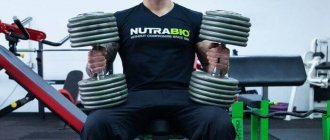Many amateur weightlifters, in addition to strength training, also perform aerobic exercise, because it is good for health and helps get rid of fat. However, some researchers have noted that regularly combining aerobic and strength training slows gains in strength and muscle size.
Why is it believed that aerobic exercise reduces the effectiveness of strength training?
In 1980, Robert Hickson, an employee of the University of Illinois (Chicago, USA), published a paper in which he showed that after strength training combined with aerobic exercise, muscle strength increases more slowly than as a result of strength training alone. Strength training in this study was done three times a week, and aerobic training was done six times a week, and when training sessions were on the same day, there was at least a two-hour break in between.
Thirty-two years later, specialists from the University of Tampa (USA) also described this effect, although there were other studies that did not find a negative effect of aerobic training on increasing muscle strength.
According to some data, aerobic training carried out simultaneously with strength training negatively affects other indicators, including explosive or rapid strength (the ability to develop maximum force in the shortest time), muscle power and muscle size. It turns out that combining strength training with aerobic exercise is ineffective.
Over time, even special terminology for labeling appeared. The combination of strength and aerobic programs was called "competitive training", and the negative effect of aerobic exercise on the adaptations usually resulting from strength training was called the "interference effect".
But why does this effect occur?
Why train explosive strength?
If you are into strength sports, be sure to add classes to improve explosiveness into your training process.
Weightlifting, powerlifting, crossfit - in each of these areas, explosive training is a key element in the preparation of athletes.
Bodybuilding may also have phases of training that focus on improving this quality.
Basically, this happens during the period of mass gain, when there is a need to increase strength indicators.
Why might the interference effect occur?
Part I
To explain the interference effect, researchers focused on the negative effect of training on muscle growth. Now this decision seems strange, since the mechanisms underlying the increase in strength are different from those that provide the development of rapid strength and power.
When a muscle increases in size greatly, it loses the ability to contract quickly, so increasing muscle size is more about developing strength than rapid strength and power.
But we know this now, and then some researchers suggested that signaling molecules that are synthesized after aerobic exercise may suppress the action of other signaling molecules that stimulate muscle growth after strength training.
During exercise, receptors in different parts of the body record the stress that the body experiences during a particular exercise and send signals that ultimately allow the body to adapt to these changes. During aerobic exercise, the number of mitochondria in muscle fibers increases, due to which the muscles more actively consume oxygen and synthesize ATP. The density of the capillaries surrounding the muscle fibers increases, and they are better supplied with blood. During strength training, the adaptation consists of increasing the length and diameter of muscle fibers, which leads to an increase in muscle volume.
At first, experts assumed a rather intricate chain of events. After aerobic exercise, the enzyme 5'-adenosine monophosphate-activated protein kinase (AMPK) is activated. This enzyme inhibits a signaling pathway called target of rapamycin (mTOR). The mTOR pathway is typically activated after resistance training. Thanks to it, protein synthesis in the muscles is accelerated, causing more proteins in the muscle fibers, and they increase in volume.
AMPK is a cellular energy sensor and responds to low intracellular concentrations of energy molecules, glycogen or ATP. Typically, these molecules become depleted after prolonged exercise. AMPK also triggers several adaptation processes after endurance training, including enhancing the activity of the PGC-1⍺ receptor, which plays a key role in cellular energy metabolism. As a result of this activation, the number of mitochondria increases. It would be logical to expect that AMPK activity on days that include two workouts, aerobic and strength training, would be higher than on days with only strength training.
However, this hypothesis was not confirmed. A few years ago, Swedish researchers discovered that two training sessions carried out one after the other did not suppress the mTOR signaling pathway, even when the activity of AMPK and PGC-1⍺ was significantly increased.
Part II
Since AMPK was found to be innocent of the interference effect, the researchers turned their attention to other signaling pathways that may influence muscle growth. However, this approach assumes that the signaling molecules that are synthesized after endurance exercise actually influence muscle growth, and the challenge is to find such molecules. However, such confidence is not based on anything.
However, scientists have proposed two possible reasons for the interference effect.
The first candidate is the protein sirtuin 1, whose activity increases after aerobic exercise. It is involved in mitochondrial biogenesis, can suppress the mTOR pathway, and its activity is associated with the activity of AMPK. Thanks to the latter circumstance, researchers first attributed to AMPK the role that sirtuin 1 actually plays.
A second possible route of interference is endoplasmic reticulum stress (ER stress), which can be caused by aerobic exercise. The endoplasmic reticulum is an intracellular network of membrane-bounded tubules. Protein synthesis occurs in it, where they are folded into a tertiary structure. If the proteins cannot fold correctly, they remain inside the network for some time. When too many proteins accumulate, they clog the lumen of the reticulum and put it in a stressful state. ER stress interferes with the normal synthesis of proteins, including muscle proteins, and thus slows down muscle growth. Like AMPK activity, ER stress can be caused by the depletion of cellular energy carriers, and this explains why some researchers have identified AMPK as the main culprit of the interference.
Despite the interest that these two hypotheses generate, they have not yet been proven and may not withstand experimental testing.
Strength endurance
Strength endurance refers to the ability to maintain muscular effort for an extended period of time. In fact, this can be called endurance, but in the source for the beauty of the set it was classified specifically as a type of strength.
Endurance relies on the efficiency of delivering oxygen and nutrients to working muscles while removing metabolic waste.
Examples : triathlon, digging up a vegetable garden, high-volume strength training in the gym.
Benefits of Developing Strength Endurance:
o Improvement of aerobic muscle performance.
o Improved performance in everyday activities.
How to train:
Of course, the bulk of strength endurance training occurs directly during long-term strength loads - for example, cycling, if you need to increase endurance for cycling, and so on. However, to train endurance you also need strength training in the gym. Triathlon coach Igor Leonovich (about whom we write in the series about preparing for the 70.3 triathlon in Turkey) considers the best method of training endurance in the gym to be static-dynamic exercises according to the method of Professor Seluyanov. There is also a more traditional view, described in the text “Strength Training for Runners.”
In the source for this text, the authors recommend that when training endurance, the main emphasis is on multi-joint movements; isolating work and exercises with body weight are also allowed.
Intensity : Low to moderate, at 40-80% of 1RM.
Repetitions: 10+
Tempo : steady, from slow to fast.
Sets: 2-5+
Rest : 30-60 seconds.
An alternative (and more likely) explanation for the interference effect
This explanation belongs to Chris Beardsley and seems more likely to him, since it is simpler and there is already experimental data in its favor.
The author notes that endurance exercise causes fatigue in the nervous system. Fatigue is a decrease in the ability to produce force. It can be caused either by wasting of the muscles themselves (peripheral fatigue) or by a decreased ability of the central nervous system to activate the muscles (central nervous system fatigue).
When muscles become tired after exercise, the force each muscle fiber can produce decreases, and the central nervous system recruits more motor units to compensate for this weakness. If peripheral fatigue is very severe, such as when strength training to failure at light loads, the central nervous system mobilizes almost all the motor units and therefore the muscle fibers within the muscle. Due to fatigue, they contract slowly, and thus peripheral fatigue effectively stimulates muscle growth.
When the central nervous system gets tired, the number of motor units and muscle fibers it is able to activate decreases and will not recover until the nervous system is rested. This means that the athlete cannot recruit high-threshold motor units, which control many of the highly sensitive muscle fibers, and after strength training, these are the muscle fibers that grow.
Many studies have shown that nervous system fatigue after exercise usually resolves quickly, but can last up to three days in the case of high-volume strength training or muscle damage. This explains why high-frequency strength training is not as effective as might be expected based on the high rate of muscle protein synthesis alone. Endurance training causes deeper and longer-lasting fatigue in the central nervous system than strength training. And it is logical to assume that central nervous system fatigue caused by aerobic exercise performed immediately before or the day before strength training will still persist during strength training.
This means that aerobic training performed shortly before strength training reduces the body's ability to recruit motor units in the muscle groups being trained. Consequently, the number of muscle fibers that are affected by strength training and which are most sensitive to this training is also reduced.
Principles of force specificity
To achieve each specific goal, it is necessary to adhere to a certain power strategy. While moving a very heavy weight at a slow pace will produce one kind of force, moving a light weight at a fast pace will produce a completely different kind of force. For example, to train for maximum strength, you need to work in a very low rep range with very heavy weights, while to develop explosive strength, you need to lift moderate weights at a very fast pace.
Below we will present 7 types of strength, and you will determine which one is suitable for your goal in a given period of time.
Testing an Alternative Explanation for the Interference Effect
If the above hypothesis is correct, then the proximity and relative order of aerobic and strength training will influence the interference effect.
Aerobic training performed after strength training should reduce muscle adaptation if the resulting central nervous system fatigue persists until the next strength training session. If aerobic training is carried out immediately before strength training, the interference effect will be stronger; if you perform aerobic exercises immediately after strength training or the next day, you will be weaker.
Indeed, when strength training is performed before aerobic training, the interference effect is small, even in well-trained athletes. According to the literature, the interference effect is greater when aerobic exercise is performed immediately before strength training, compared to aerobic exercise performed immediately after strength training.
If the hypothesis is correct, we would expect the interference effect to have a greater impact on measures such as maximal strength and power than on muscle size. Indeed, literature data confirm this. This is because the ability to recruit motor units is an adaptation to long-term strength training, and this adaptation allows for increases in maximum strength and power. Failure to recruit all motor units during exercise means those muscle fibers are not trained and strength does not increase.
Circuit training rules
Strength exercises at home are most effective in a complex called circuit training. It includes up to 8 cycles of several sets of various exercises, the implementation of which is limited in time. The circuit training program includes working a large number of muscle groups. For novice athletes, it gives an excellent athletic effect, which helps to consistently lose weight.
A repetition is one exercise performed in a full cycle from contraction to stretching of the muscle being worked. Set (approach) - several identical repetitions in a row without a break.
The effect of circuit training depends on the number of repetitions:
- a set of 1-5 repetitions increases strength and muscle size, working with the maximum possible weight;
- a set of 6-12 repetitions balances strength, endurance, and muscle size;
- a set of 13-20 repetitions primarily develops endurance and has almost no effect on muscle size and strength, working with light or no weights.
For weight loss purposes, the second option is best - each set of 6-12 repetitions with a small additional load in the form of dumbbells, expanders, backpacks, etc.
What are the practical implications?
We still know little about how long central nervous system fatigue lasts after different types of exercise, although fatigue is greater after longer exercise.
We also know little about which types of exercise cause severe central nervous system fatigue and which cause milder central nervous system fatigue, although muscle damage is known to aggravate this fatigue even when training lasts only a short time.
Practically, this means that if we want to include aerobic exercises in a strength training program, they should not be performed immediately after strength exercises, they should not be done for long periods of time, and exercises that often injure the muscles, such as running, should be avoided.
Relative strength
The amount of force per 1 kg of an athlete’s weight is called relative. If neuromuscular coupling and maximal strength increase while the athlete's body weight remains the same, relative strength increases.
Example : 2 athletes with the same weight perform a deadlift. The first lifts 220 kg, and the second lifts 235 kg. Since the second athlete is able to produce more force per 1 kg of his body weight, his relative strength is higher than that of the first athlete.
Benefits of Developing Relative Strength:
o Increased intramuscular coordination.
o Improved neuromuscular communication.
o Increased functionality in different sports.
How to train:
Relative strength can be increased by using any of the presented strength styles. An indicator of its growth is the progression in working weights while maintaining or reducing the athlete’s weight.
And the final conclusion
Combining aerobic exercise with strength training slows muscle growth. Although the accepted explanation for this effect is that signaling molecules produced after endurance exercise suppress the effects of anabolic signals, Chris Beardsley considers his own theory more plausible, according to which aerobic exercise causes fatigue in the central nervous system, which in turn reduces number of motor units recruited during subsequent strength training.
Source:
Functional strength
Functional strength refers to the ability to generate and control forces in the context of daily living.
While traditional strength training is aimed at producing muscle contractions in order to move weight along a clear path in one plane, in everyday life there is a constant need to move something heavy in several planes at once.
Roughly speaking, if you need to carry bags of cement, then train your ability to carry heavy bags.
Examples : lifting and carrying a child, a bag or a refrigerator.
Benefits of Developing Functional Strength:
o Improving the elasticity of muscles and connective tissue.
o Reducing the risk of pulling a muscle and getting a sprain.
o Increased functionality in different sports.
o Improved performance in everyday activities.
How to train:
To develop functional strength, it is necessary to use movements that allow you to move weight in different planes. Choose exercises using dumbbells, sandbags, medicine balls and cable machines.
Intensity: Low to moderate, at 50-75% of 1RM (repetition maximum) for each individual exercise.
Number of repetitions: 12-15+
Tempo: variable, from slow to fast.
Sets: 2-5+
Rest: 30-90 seconds.
Starting force
Starting strength is the ability to produce force without first stretching the muscle, due to which mechanical energy is “loaded”. In other words, the starting force is produced by a movement that starts from a stationary position.
Examples : first second of sprint, getting up from a sitting position.
Advantages:
o Increases the ability of muscles and connective tissue to produce force.
o Accelerates the initial phase of movement in those sports where it is required to make an effort from a stationary position.
How to train:
Use of multi-joint and isolation exercises with an emphasis on maximizing force production early in the movement.
Intensity : Moderate to high, at 50-90% of 1RM.
Approaches: 1-6
Tempo : fast, explosive.
Sets: 2-6+
Rest : 45 seconds to 3 minutes.
Speed Force
Speed strength is trained through efforts that the muscles are capable of producing at the highest possible speed.
Examples : sprinting, throwing a baseball.
Advantages:
o Improved response.
o Improved athletic performance.
o Reducing the time between muscle relaxation and contraction.
How to train:
Perform multi-joint exercises using your own body weight or a minimal set of equipment in a maximum speed style.
Intensity : low to moderate, at 30-50% of 1RM.
Repetitions: 1-6
Tempo : fast, explosive.
Sets: 2-6+
Rest : from 30 seconds to 2 minutes.











